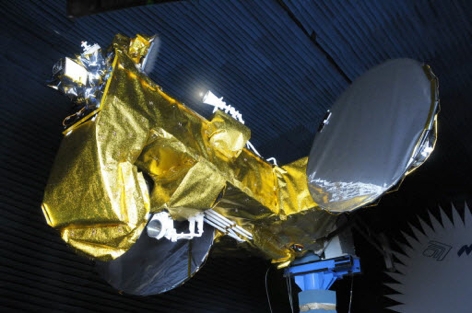As the nation is gripped by World Cup fever it is easy to forget about the technology that enables us to watch all 64 matches live from South Africa.
Before you settle down to watch the next game, spare a thought for the satellites orbiting 36,000km above your head, broadcasting high quality pictures of Capello’s men and the other teams, together with the controversial drone of the vuvuzelas.
We now take for granted the ability to switch on the TV and tune in to live sport, even if the action is taking place nearly 10,000km away. Picking up relatively weak broadcast signals from Earth, telecommunications satellites boost the signals in space and broadcasters distribute them to millions of TV sets worldwide, without you missing a kick. It certainly wasn’t the satellites’ fault last Friday!
As you watch the action from South Africa, the likelihood is that you are receiving your football fix from a satellite built right here in the UK. At Astrium we specialise in the design and manufacture of telecommunications satellites and currently have a 25% share of the world market.
At our site in Portsmouth we develop satellite payloads. These are essentially the brains of any satellite, consisting of hundreds of transponders designed to receive, boost and send signals back to Earth.
It always gives me a great sense of pride to see a finished payload leave one of our facilities as it represents up to 18 months of high precision engineering at the cutting edge of telecommunications.
Since we introduced the first Eurostar series of satellites back in 1990 they’ve clocked up over 350 years of successful in-orbit operations.
Just last month I watched the payload for Astra 1N, a telecommunications satellite for the operator SES, leave our facility in Portsmouth, and it got me thinking about how far this type of spacecraft has come in the past 25 years.
When you consider the capabilities telecommunications satellites now have, it’s not difficult to see why satellite broadcasting has become such a commercial success. During my career I have seen a series of continuous improvements, as consumers have become more demanding of satellite broadcasters.
Our work has therefore been driven by enabling our customers to provide more and more capacity on the satellites we build, so that they can be used to broadcast everything from live sport, 24 hour news, minute by minute weather updates and even repeat episodes of Only Fools and Horses, across the globe.
The success of telecommunications satellites can be defined by both their range of coverage and their broadcast capacity. Conceptually, broadcasting via satellite is the same as broadcasting from a terrestrial antenna – they both transmit radio waves, but the key limitation with a terrestrial antenna is the range of the signal.

Most radio signals can only travel for about 50 to 65 kilometres from their source before the curvature of the Earth breaks up the signal’s line of sight. If the Earth was perfectly flat then you could broadcast for thousands miles from source, but since the days of Christopher Columbus we have known this not to be the case.
Satellites therefore offer an effective solution to this problem, connecting the world to global events from their lofty position out in space. They also provide vital communication links to other parts of the world which have not spent the best part of 100 years developing their own terrestrial communication networks. For parts of Africa, South America and Asia, where terrestrial networks can be intermittent, telecommunication satellites provide a ready made solution not just for media broadcasting but also for telephony and broadband internet services.
The sheer capacity of telecommunication satellites also sets them apart. Just ten years ago they could broadcast up to 20-30 channels simultaneously. Now capable of generating up 14Kw of power, today’s figure is closer to 500 TV channels, or up to 4,000 radio stations – not bad for something that runs purely on sunshine.
Today we are now at a stage where we build telecommunications satellites to operate continuously, 24 hours a day, for a minimum period of 15 years. That’s pretty exceptional reliability considering there is no way of servicing them in space. Since we introduced the first Eurostar series of satellites back in 1990 they’ve clocked up over 350 years of successful in-orbit operations.
So as you watch the football, don’t get too upset if there’s an occasional flicker on the screen – the signal has just done a 72,000km round trip, reaching your TV in a matter of nanoseconds!
Bob Graham is head of engineering at EADS Astrium, based at its Portsmouth facility. His thoughts will appear regularly on our blog pages, bringing news and opinion from the engineering floor and design studio of Europe’s biggest satellite maker. Bob welcomes your comments but cannot enter into correspondence on these pages.




Viking Link connects UK and Danish grids
These underwater links must, based on experience with gas pipelines, be vulnerable to sabotage by hostile powers. Excessive dependency on them could...